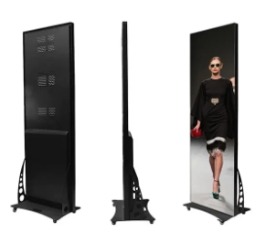Don't wanna be here? Send us removal request.
Text
The Evolution and Benefits of LED Advertising Boards

In today's fast-paced digital world, businesses are constantly seeking innovative ways to capture attention and engage their target audience. One of the most effective tools in modern advertising is the LED advertising board. These dynamic displays have revolutionized outdoor and indoor marketing, offering vibrant visuals, flexibility, and high visibility.
This article explores the evolution, advantages, and applications of LED advertising boards, highlighting why they have become a preferred choice for businesses worldwide.
What Is an LED Advertising Board?
An LED advertising board is a digital display that uses light-emitting diodes (LEDs) to showcase advertisements, messages, or multimedia content. Unlike traditional static billboards, these boards can display moving images, videos, and real-time updates, making them highly engaging.
Types of LED Advertising Boards
Outdoor LED Billboards – Large-scale displays used in high-traffic areas like highways, stadiums, and city centers.
Indoor LED Displays – Found in malls, airports, and retail stores for promotions and information dissemination.
Mobile LED Screens – Mounted on vehicles for dynamic mobile advertising.
Transparent LED Panels – Used in storefronts, allowing visibility through the screen while displaying ads.
The Evolution of LED Advertising Boards
The journey of LED advertising boards began with simple monochrome displays in the late 20th century. Over time, advancements in LED technology led to full-color, high-resolution screens capable of delivering stunning visuals.
Key Milestones:
1980s: Introduction of basic LED signs for text-based messages.
1990s: Development of color LED displays for more dynamic advertising.
2000s: High-definition (HD) and ultra-bright LEDs for outdoor visibility.
2010s-Present: Smart LED boards with interactive features, remote content management, and energy-efficient designs.
Today, LED advertising boards incorporate AI-driven content optimization, real-time data integration, and even touch-screen interactivity.
Advantages of LED Advertising Boards
1. High Visibility and Brightness
Unlike traditional print ads, LED advertising boards are visible day and night. Their high brightness ensures readability even in direct sunlight, making them ideal for outdoor promotions.
2. Dynamic and Engaging Content
Static billboards can only display one message, whereas LED advertising boards can rotate multiple ads, play videos, and even interact with viewers through motion sensors.
3. Cost-Effective in the Long Run
While the initial investment may be higher than printed billboards, LED advertising boards eliminate printing and installation costs for new campaigns. Content can be updated instantly via remote software.
4. Eco-Friendly Advertising Solution
LED technology consumes less power compared to traditional neon or fluorescent signs. Many modern LED advertising boards use solar power, further reducing their environmental impact.
5. Real-Time Updates and Flexibility
Businesses can change promotions instantly based on trends, weather, or events. For example, a restaurant can update its menu in real time, or a retailer can flash a limited-time discount.
6. Increased Brand Recall
The dynamic nature of LED advertising boards captures attention more effectively than static ads, leading to better brand recognition and customer engagement.
Applications of LED Advertising Boards
1. Retail and Shopping Malls
Stores use LED advertising boards to highlight promotions, new arrivals, and discounts, enhancing the shopping experience.
2. Sports Stadiums and Events
From live scores to sponsor ads, LED screens provide an immersive experience for spectators.
3. Transportation Hubs (Airports, Train Stations)
Real-time flight updates, directional information, and advertisements keep travelers informed and engaged.
4. Corporate Branding
Companies install LED advertising boards at headquarters or trade shows to reinforce brand identity with dynamic visuals.
5. Public Safety and Information
Governments and municipalities use LED displays for emergency alerts, traffic updates, and public service announcements.
Future Trends in LED Advertising Technology
The future of LED advertising boards is driven by innovation. Some emerging trends include:
AI-Powered Content Optimization: Algorithms analyze viewer demographics to display the most relevant ads.
Augmented Reality (AR) Integration: Interactive ads where users can engage with the display via smartphones.
Ultra-High-Definition (UHD) Displays: 8K resolution for sharper and more realistic visuals.
Energy-Efficient Designs: Solar-powered and low-energy-consumption LEDs for sustainability.
1 note
·
View note